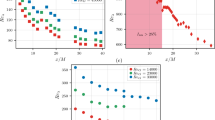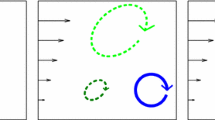Abstract
All three components of the vorticity fluctuation have been measured simultaneously in a turbulent wake using a new eight-sensor vorticity probe. The vorticity fluctuation spectra agree reasonably well with those from a direct numerical simulation of a turbulent channel flow at high wavenumbers. The similarity between the instantaneous energy dissipation rate ε and the instantaneous enstrophy ω2 is examined using spectra and probability density functions. The correlation between ω2 and ε is evaluated in some detail. The homogeneous value of ε is strongly correlated with ω2. The full value of ε and, more especially its isotropic value, are less well correlated with the enstrophy. Conditional averaging indicates that high enstrophy regions are associated with high energy dissipation rate regions.
Similar content being viewed by others
References
Antonia, R.A. and Kim, J., A numerical study of local isotropy of turbulence.Phys. Fluids A 6 (1994) 834–841.
Antonia, R.A., Browne, L.W.B. and Shah, D.A., Characteristics of vorticity fluctuations in a turbulent wake.J. Fluid Mech. 189 (1988) 349–365.
Antonia, R.A., Shah, D.A. and Browne, L.W.B., Dissipation and vorticity spectra in a turbulent wake.Phys. Fluids 31 (1988) 1805–1807.
Antonia, R.A., Kim, J. and Browne, L.W.B., Some characteristics of small scale turbulence in a turbulent duct flow.J. Fluid Mech. 233 (1991) 369–388.
Antonia, R.A., Zhu, Y. and Shafi, H.S., Lateral vorticity measurements in a turbulent wake.J. Fluid Mech. 323 (1996) 173–200.
Ashurst, W.T., Kerstein, A.R., Kerr, R.M. and Gibson, C.H., Alignment of vorticity and scalar gradient with strain rate in simulated Navier-Stokes turbulence.Phys. Fluids 30 (1987) 2343–2353.
Balint, J.-L., Wallace, J.M. and Vukoslavčević, P., The velocity and vorticity vector fields of a turbulent boundary layer. Part 2. Statistical properties.J. Fluid Mech. 228 (1991) 53–86.
Bershadskii, A., Kit, E. and Tsinober, A., On universality of geometrical invariants in turbulence-experimental results.Phys. Fluids A 5 (1993) 1523–1525.
Browne, L.W.B. and Antonia, R.A., Reynolds shear stress and heat flux measurements in a cylinder wake.Phys. Fluids 29 (1986) 709–713.
Browne, L.W.B., Antonia, R.A. and Chua, L.P., Calibration of X-probes for turbulent flow measurements.Expts. in Fluids 7 (1989) 201–208.
Browne, L.W.B., Antonia, R.A. and Shah, D.A., Turbulent energy dissipation in a wake,J. Fluid Mech. 179 (1987) 307–326.
Corrsin, S. 1953. Remarks on turbulent heat transfer: An account of some features of the phenomenon in fully turbulent regions. In:Proc. The Iowa Thermodyn. Sym., University of Iowa (1953) pp. 5–30.
Corrsin, S. and Kistler, A.L., Free-stream boundaries of turbulent flows, Technical Report 1244, NACA (1955).
Freytag, C., Statistical properties of energy dissipation.Boundary-Layer Meteorol. 14 (1978) 183–198.
Gibson, C.H. and Masiello, P.J., Observations of the variability of dissipation rates of turbulent velocity and temperature fields. In: Ehlers, J., Hepp, K. and Weidenmuller, H.A. (eds),Statistical Models and Turbulence, Lecture Notes in Physics, Vol. 12 (1972), pp. 427–453.
Kerr, R.M., High-order derivative correlations and the alignments of small-scale structures in isotropic numerical turbulence.J. Fluid Mech. 153 (1985) 31–58.
Kim, J., Moin, P. and Moser, R., Turbulent statistics in fully developed channel flow at low Reynolds number.J. Fluid Mech. 177 (1987) 133–166.
Kit, E., Tsinober, A. and Dracos, T., Velocity gradients in a turbulent jet flow. In: Nieuwstadt, F.T.M. (ed.),Advances in Turbulence IV, Kluwer Academic Publishers, Dordrecht (1993) pp. 185–190.
Lemonis, G.C., An experimental study of the vector fields of velocity and vorticity in turbulent flows, Ph.D. Thesis, Swiss Federal Institute of Technology, Zurich (1995).
Marasli, B., Nguyen, P. and Wallace, J.M., A calibration technique for multiple-sensor hot-wire probes and its application to vorticity measurements in the wake of a circular cylinder.Expts. in Fluids 15 (1993) 209–218.
Meneveau, C., Sreenivasan, K.R., Kailasnath, P. and Fan, M., Joint multifractal measures: Theory and applications to turbulence.Phys. Rev. A 41 (1990) 894–913.
Mi, J. and Antonia, R.A., Vorticity characteristics of the turbulent intermediate wake.Expts. in Fluids 20 (1996) 383–392.
Owen, R.G., An analytical turbulent transport model applied to nonisothermal fully-developed duct flows, Ph.D. Thesis, Pennsylvania State University (1973).
Park, S.R. and Wallace, J.M., The influence of instantaneous velocity gradients on turbulence properties measured with multi-sensor hot-wire probes.Expts. in Fluids 16 (1993) 17–26.
Perry, A.E., Lim, K.L. and Henbest, S.M., An experimental study of the turbulence structure in smooth and rough-wall boundary layers.J. Fluid Mech. 177 (1987) 437–452.
Rogers, M.M. and Moin, P., Helicity fluctuations in incompressible turbulent flows.Phys. Fluids 30 (1987) 2662–2671.
Ruetsch, G.R. and Maxey, M.R., Small-scale features of vorticity and passive scalar fields in homogeneous isotropic turbulence.Phys. Fluids A 3 (1991) 1587–1597.
Shafi, H.S., Zhu, Y. and Antonia, R.A., Intermittency of vorticity in a turbulent shear flow.Phys. Fluids 8 (1996) 2245–2247.
She, Z.-S., Jackson, E. and Orszag, S.A., Intermittent vortex structures in homogeneous isotropic turbulence.Nature 344 (1990) 226–228.
Spalart, P.R., Direct simulation of a turbulent boundary layer up to Rθ=1410.J. Fluid Mech. 187 (1988) 61–98.
Tennekes, H. and Lumley, J.L.,A First Course in Turbulence. MIT Press, Cambridge, MA (1972).
Tsinober, A., On the property of Lamb vector in isotropic turbulent flow.Phys. Fluids A 2 (1990) 484–486.
Tsinober, A., How important are direct interactions between large and small scales in turbulent flows. In: Dracos, T. and Tsinober, A. (eds),New Approaches and Concepts in Turbulence. Basel, Birkhäuser Verlag (1993) pp. 141–150.
Tsinober, A., Geometrical statistics in turbulence. In: Gavrilakis, S., Machiels, L. and Monkewitz, P.A. (eds),Advances in Turbulence VI, Kluwer Academic Publishers, Dordrecht (1996) pp. 263–266.
Tsinober, A., Kit, E. and Dracos, T., Experimental investigation of the field of velocity gradients in turbulent flows.J. Fluid Mech. 242 (1992) 169–192.
Vukoslavčević, P., Wallace, J.M. and Balint, J.-L., The velocity and vorticity vector fields of a turbulent boundary layer. Part 1: Simultaneous measurement by hot-wire anemometry.J. Fluid Mech. 228 (1991) 25–51.
Wallace, J.M. and Foss, J.F., The measurement of vorticity in turbulent flows.Ann. Rev. Fluid Mech. 27 (1995) 467–514.
Wallace, J.M., Balint, J.-L. and Ong, L., An experimental study of helicity density in turbulent flows.Phys. Fluids A 4 (1992) 2013–2026.
Zhu, Y. and Antonia, R.A., Effect of wire separation on X-probe measurements in a turbulent flow.J. Fluid Mech. 287 (1995) 199–233.
Zhu, Y. and Antonia, R.A., Spatial resolution of a 4-X-wire vorticity probe.Meas. Sci. & Technol. 7 (1996) 1492–1497.
Author information
Authors and Affiliations
Rights and permissions
About this article
Cite this article
Zhu, Y., Antonia, R.A. On the correlation between enstrophy and energy dissipation rate in a turbulent wake. Appl. Sci. Res. 57, 337–347 (1996). https://doi.org/10.1007/BF02506068
Received:
Accepted:
Issue Date:
DOI: https://doi.org/10.1007/BF02506068




